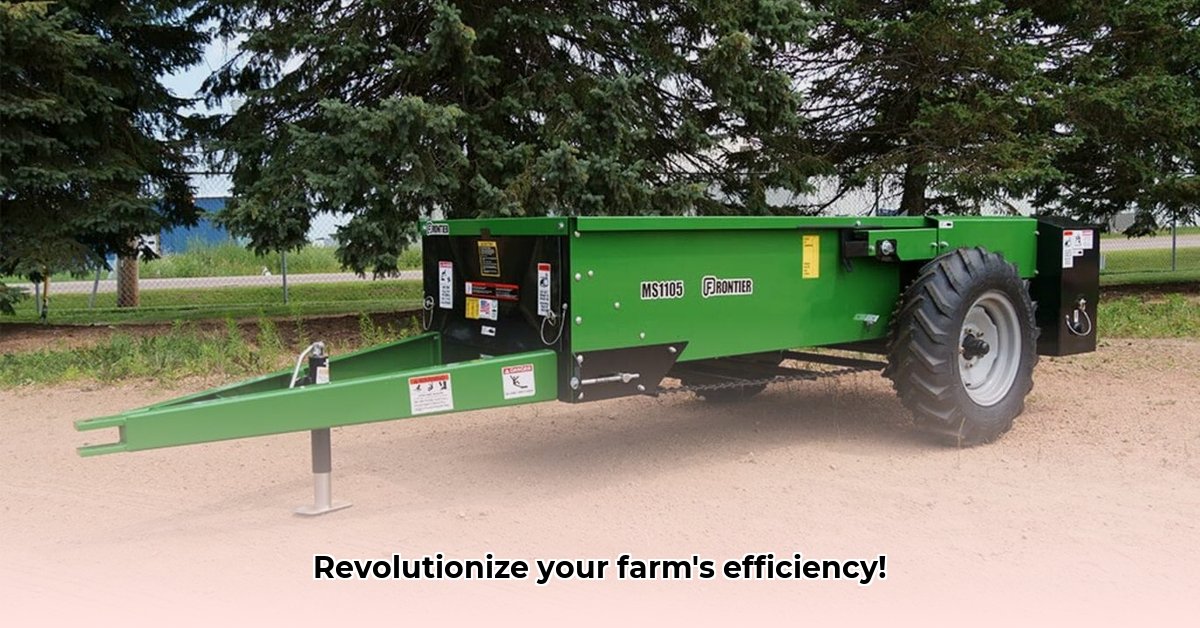
Capacity and Spread Width: A Powerful Performer?
The Earth & Turf MultiSpread 320 boasts a significant capacity of 27 cubic feet for sand, expanding to 54 cubic feet for lighter materials like compost and topsoil. This large capacity translates directly to increased efficiency, minimizing the number of trips required to cover a given area. This is further enhanced by an adjustable spread width, extending up to 60 inches wide when using optional side wings. This adjustability allows for customization to various project sizes, from small gardens to large fields, optimizing material usage and reducing waste. But can it truly deliver on its promises of efficiency and improved material management? For more on pull-behind spreaders, check out this helpful resource. Let's delve deeper.
Durable Construction: Built to Last?
The MultiSpread 320 is constructed using commercial-grade materials, promising robust durability for sustained heavy use. This translates to a longer lifespan, reducing the need for frequent replacements and minimizing downtime. However, the potential for increased maintenance costs over the product's life cycle should still be considered during the purchasing decision. Are the long-term cost savings worth the initial investment?
Material Versatility: Beyond Compost
This tow-behind spreader isn't confined to compost; it readily handles topsoil, sand, and other soil amendments. This adaptability makes it a valuable asset for diverse applications, ranging from farming and agriculture to landscaping and groundskeeping. Its broad use cases make it a worthwhile purchase for those seeking a versatile and efficient material spreader for multiple jobs. However, the manufacturer's specifications concerning the maximum effective weight when using side extensions could be more clear.
Key Considerations Before Purchase
While the MultiSpread 320 offers impressive capabilities, potential buyers should consider several factors. The weight limit of 2700 lbs, while substantial, is significantly impacted by the use of optional side extensions, especially when handling heavier materials like sand. Furthermore, the lack of readily available pricing and availability information directly from the manufacturer's website necessitates contacting a dealer, adding a level of inconvenience to the purchasing process. These factors, while not necessarily dealbreakers, require careful consideration. Is the potential for long-term cost savings overshadowed by these drawbacks?
Five Steps to Informed Purchasing
Assess Your Needs: Carefully evaluate your typical workload, considering both the volume and type of materials handled. This will help determine if the MultiSpread 320's capacity aligns with your requirements.
Compare and Contrast: Research comparable models from other manufacturers, comparing features, capacities, and price points to ensure you obtain optimal value.
Factor in Maintenance: Budget for routine maintenance and potential repairs, alongside the initial purchase price, for comprehensive cost projection.
Explore Financing: Consider financing options like leasing or loans to manage the significant investment cost more effectively.
Prioritize a Hands-on Evaluation: Seek a demonstration of the spreader to directly assess its handling characteristics and spreading efficacy, ensuring a comfortable and effective fit with your workflow.
Weighing the Pros and Cons
| Pros | Cons |
|---|---|
| High capacity (material-dependent) | Weight limitations (especially with heavier materials) |
| Versatile material handling | Inconvenient access to pricing and availability data |
| Durable, commercial-grade construction | Requires regular maintenance |
| Adjustable spread width | Potential need for additional accessories |
| Suitable for varied applications | Shipping costs may vary by location |
The Bottom Line: Is the MultiSpread 320 Right for You?
The Earth & Turf MultiSpread 320 offers substantial potential for boosting efficiency in farming and landscaping. However, careful consideration of its weight limitations and the need for additional research regarding pricing and availability are crucial before committing to a purchase. Ultimately, the optimal choice depends on individual needs and budget constraints. Thorough research is paramount before making this investment.
Optimizing Compost Spreader Application for Different Soil Types
The MultiSpread 320's effectiveness hinges on proper settings tailored to specific soil types.
Sandy Soils: Utilize finer settings for precise spreading to prevent nutrient loss, adjusting application frequency based on moisture retention.
Clay Soils: Employ wider settings to enhance penetration, applying compost less frequently but more thoroughly to avoid compaction.
Loam Soils: Moderate settings usually suffice, with ongoing monitoring and adjustment as needed based on soil response.
Proper compost preparation – ensuring consistent moisture but avoiding sogginess and breaking up clumps – is crucial for preventing clogs and ensuring even distribution, regardless of soil type. Regular calibration and cleaning after each use will maximize the lifespan and efficiency of the MultiSpread 320.